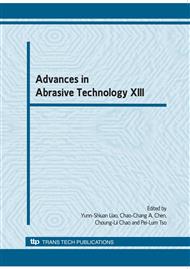p.981
p.987
p.995
p.1001
p.1007
p.1013
p.1019
p.1023
p.1029
Surface Roughness and Morphology of Titanium Plate Ground with Fixed and Loose Brown Alumina Abrasives
Abstract:
Titanium is a metal material which has many excellent properties; it has been widely used in many fields. In this paper, plane abrasive machining is carried out for Titanium plate. The surface roughness and morphology of Ti-plate is compared after fixed and loose abrasive machining. The experiment proved that the drop magnitude of Ra in loose abrasives machining is great larger than that in fixed abrasive when grit size is nearly equal, and the improvement of surface defect such as some directional marks, deep scratch and bits in loose abrasives machining is rapider and quicker than that in fixed abrasives during same machining time. The results of experiments indicts that loose abrasive machining is better than fixed abrasive in reducing surface roughness and improving surface morphology, since the higher density of active abrasives and machining force uniformity.
Info:
Periodical:
Pages:
1019-1022
Citation:
Online since:
August 2010
Authors:
Price:
Сopyright:
© 2010 Trans Tech Publications Ltd. All Rights Reserved
Share:
Citation:


